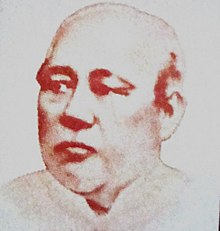Ambrosio Rianzares Bautista
Ambrosio Rianzares Bautista | |
|---|---|
 Photo of Ambrosio Rianzares Bautista from a stamp | |
| Member of the Malolos Congress from Bulacan | |
| In office September 15, 1898 – November 13, 1899 Serving with Mariano Crisostomo, Pedro Serrano, and Trinidad Iscasiano | |
| Personal details | |
| Born | Ambrosio Rianzares Bautista y Altamira December 7, 1830 Biñan, La Laguna, Captaincy General of the Philippines |
| Died | December 4, 1903 (aged 72) |
| Cause of death | Accidental fall from a Horse-drawn vehicle |
| Alma mater | University of Santo Tomas |
| Occupation | Lawyer |
| Known for | Author of the Declaration of Philippine Independence |
Ambrosio Rianzares Bautista y Altamira (December 7, 1830 – December 4, 1903), also known as Don Bosyong, was a Filipino lawyer and author of the Declaration of Philippine Independence. A distant relative to the Rizal family and the Bonifacio family, Bautista often gave advice to José Rizal, a Filipino nationalist, while studying in Manila.[1]
Early life and career in the Malolos Congress
Bautista was born in Biñan, Laguna, to Gregorio Enriquez Bautista and Silvestra Altamira. He attended preparatory school in Biñan and studied law at University of Santo Tomas, obtaining a degree in 1865. He practiced law in Manila and offered free legal services to poor clients. Whilst practicing law, Bautista, on his way to Malolos, Bulacan, was captured by a group of bandits, who subsequently learned that he saved many of their friends as a defender of the poor in court cases against rich Filipinos and Spaniards. The bandits apologized to Bautista and set him free.
Political activism
Bautista solicited funds to finance a campaign for reforms in the Philippines, later becoming a member of the La Liga Filipina, Cuerpo de Compromisarios and La Propaganda. In 1896, the Spaniards arrested and imprisoned him at Fort Santiago, as he was suspected of being involved in the Philippine Revolution; Bautista elected to defend himself and was later released from prison.
In 1898, Bautista became the first adviser to President Emilio Aguinaldo and subsequently wrote the Declaration of Philippine Independence.[2]
Contrary to common belief, it was Bautista, and not Aguinaldo, who waved the Philippine flag before the jubilant crowd on June 12, 1898, during the Philippines Proclamation of Independence in Cavite.[3][2]
On July 14, 1899, Bautista was elected to the position of president in Tarlac's Revolutionary Congress and was later appointed judge of the Court of First Instance of the province of Pangasinan.[4]
In popular culture
- Portrayed by Richard Manabat in the 2012 film, El Presidente.
See also
Further reading
- Bautista Rianzares Ambrosio. 1830 - 1903 (accessed on September 10, 2007)
- Quirino, Carlos. Who's Who in Philippine History. New York: Home Books. 1995.
- National Historical Institute. Historical Markers: Regions I-IV and CAR. Manila: National Historical Institute. 1993
- "Southern Luzon and Bicol: Ambrosio Rianzares Bautista." Unsung Heroes of the Philippines Revolution - MSC Communications Technologies, Inc.. (accessed September 12, 2007).
References
- ^ "Unveiling Biñan's Gallant History | Sangguniang Panlungsod ng Biñan". Sangguniang Panlungsod ng Biñan (City Council of Biñan). 2017-12-29. Retrieved 2021-07-13.
- ^ a b Bauzon, Kenneth E. (2019). Capitalism, The American Empire, and Neoliberal Globalization. Themes and Annotations from Selected Works of E. San Juan, Jr. Palgrave Macmillan and De La Salle University Publishing House. p. 85. ISBN 9789813290808.
- ^ Dumindin, Arnaldo (2006). "Philippine-American War, 1899-1902".
- ^ "Office of the U.S. Military Governor in the Philippine Islands General Orders No. 1–93 (Jan.–June 1900)". General Orders No. 1: 2. 2 January 1900. Retrieved 3 August 2021.